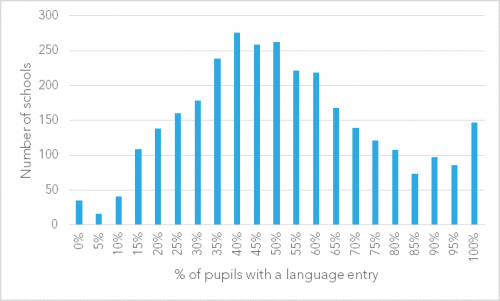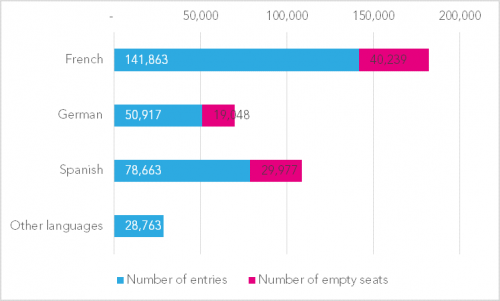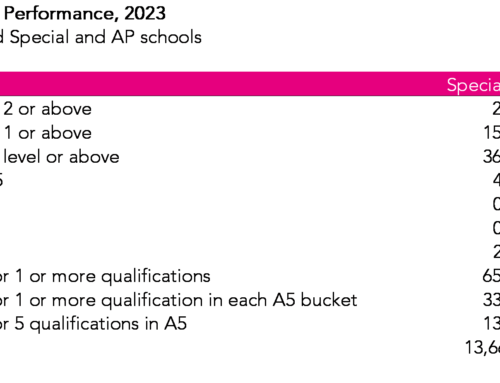Last year we said we thought we needed about 2,500 extra language teachers to deliver the manifesto commitment to teach the EBacc to all students at KS4. In 2015, 50% of students in state mainstream schools were entered for a GCSE language, so achieving universal provision is an enormous undertaking. Some of these students can sit in the ‘empty seats’ of existing language classes; others will need new classes to be created to accommodate them. We have revised our analysis and now think it is reasonable to assume we need as many as 3,400 new language teachers to deliver EBacc for all. This blog sets out all the assumptions we make in arriving at this figure.
This first chart shows the extent of the problem in secondary schools. At just 1-in-10 schools, almost every student takes a GCSE language. Many of these are selective schools, but others have maintained a commitment to languages for all.[1] Pupils taking a language GCSE have become a minority in the typical secondary school.
Percentage of pupils with a language GCSE entry by secondary school

Many of these existing KS4 pupils are taking their language studies in a classroom with empty seats, so schools can increase the number of pupils taking a language entry without hiring new teachers. To estimate how many new entries can be achieved this way, we make the following assumptions:
- There are only useful empty seats in French, German and Spanish GCSE classes. The majority of the other modern language entries are for community languages, which either have no class or cannot be offered to those not speaking the language at home. There are part-filled Latin and Greek classes, but these are largely in schools where almost everyone takes a language so do not materially help us here.
- If there are only 3 or fewer entries in the language then we assume the school is not running a class and that entries are native speakers or those studying in after-school arrangements.
- A full class is 30 students. This means that if a school has 32 French entries, we assume they are running 2 year 11 classes with 28 empty seats.
The chart below shows that there are about 90,000 empty seats in French, German and Spanish classrooms right now. But here is the problem: 10% of them are in schools where they cannot be given to somebody not currently taking a language. We can only use 79,000 of these empty seats to provide a GCSE language entry for somebody not currently taking one.
Estimated number of empty seats in existing language classrooms

All these empty seats allow us to increase the number of students with a language entry from 50% to 65% without having to worry about hiring new teachers. The chart below shows how many students have a language entry across schools, once empty seats are filled. To put this in context, suppose the government imposes a requirement that 70% of students in a school must be entered for all EBacc subjects. Currently just 20% of schools meet this in terms of language entries; with filled classroom seats, 42% of schools could meet this requirement.
Percentage of pupils with a language GCSE entry once seats are filled by secondary school

Even with classrooms filled, we think there are still about 190,000 students in each KS4 year group who need a new classroom to be created for them. This amounts to 15,000 extra classrooms across schools in years 10 and 11. If we analyse this school-by-school and assume a newly hired language teacher can deliver up to 6 KS4 classes, we need to hire 3,400 extra language teachers to achieve EBacc for all.
This is just an estimate, involving a huge number of assumptions. The school-by-school analysis leaves lots of slack in the system. For example, suppose a school needs to set-up just two new KS4 language classes. Then we assume they need to hire one extra teacher, even though they would not have a full timetable in the languages department. If we imagine that language teachers can somehow be shared across schools or hired part-time, then we need 2,500 full-time equivalent (FTE) language teachers. (We also assume schools do not partake in other efficient, but unsavoury activities, such as removing the right of students to take more than one language!)
The vast majority of schools will need to hire just one new language teacher to deliver EBacc for all; about 50 schools will need to hire 3 or more, assuming adequate KS3 language provision is already secured. For each individual school, finding one extra teacher may not feel insurmountable, but with almost every school in the country trying to do this it really is. We currently train about 1,500 language teachers a year just to maintain the current stock of teachers. If anyone has any good ideas about how to recruit over 3,000 language teachers then I’m sure someone in Whitehall would be happy to take your call!






Leave A Comment